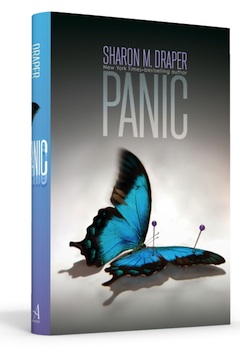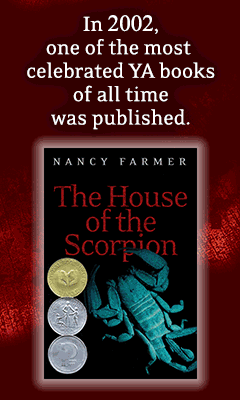Panic
by Sharon M. Draper
Sharon Draper (Out of My Mind) takes us into the heart of a closely knit dance troupe and the ways in which its members band together when two of them face a crisis. The author balances a suspenseful plot and the emotional growth of her characters with ease and grace.
Draper gives us a window into the bond that develops from working together toward a shared vision and passion. The dancers exude the kind of confidence that results from doing something well, and achieving excellence through practice. She allows readers to be a fly on the wall in the studio and in the dancers' homes, and readers will quickly feel as if they know these characters. They also seem to have been spared the image hang-ups that haunt many driven dancers. Miss Ginger, who runs the studio, cares about her students, and they know it.
The story unfolds through four alternating narrators: Justin, the 16-year-old lead male dancer with a crush on Layla Ridgewood; Layla, a sophomore and the leading female dancer, who's dating 16-year-old Cadillac-driving Donovan Beaudry; Diamond Landers, a sophomore with a tight family; and Diamond's best friend, Mercedes Ford, who wishes she drove a Mercedes, but in fact drives a Ford.
Diamond and Mercedes go on an afternoon run to the mall to buy tights for their dance showcase that evening. The author portrays the girls as responsible and sensible. But when Diamond goes on ahead to buy two slices of pizza, she meets a handsome 40-something man who tells her he's holding auditions for a film starring two of Diamond's idols, and that she'd be great for the role of the dancer. She leaves the mall with him. The man, Thane English, earns Diamond's trust through details she finds convincing: he and his family are new to the area, his daughter, Chloe, attends Broadway High School, just like Diamond, and Chloe was supposed to meet him in the food court, but Thane and his wife got their "wires crossed." The situation is all the more chilling for how well Thane has done his homework, and how easily Diamond makes the decision to go with him.
Draper never shows explicitly what goes on during Diamond's captivity, but readers discover what kind of film Thane does plan to make with Diamond, how he drugs her to get her to cooperate, and the strange men she remembers seeing enter the room.
The author gives only enough information to demonstrate that Diamond's innocence is gone, and she is forever changed. By alternating among the narrators, Draper allows readers to see the reactions of Diamond's friends and family and the progress of the investigation into her disappearance, and gives us a break from the intensity of Diamond's situation.
Meanwhile, Draper sets up a rather chilling parallel through the relationship between Layla and Donovan. He holds her on a tight leash. Donovan is jealous of the time she spends at the dance studio and especially of the attentions that Justin shows Layla, as the two lead dancers. Donovan's physical and emotional abuse turns into revenge when he e-mails some topless pictures he persuaded Layla to pose for in a tender moment, and they go viral on the Web. Draper effectively holds up a mirror between Diamond's and Layla's exploitation--one against her will, and the other willingly.
The author creates a counterpoint between the dynamics of these two situations with examples of healthy relationships, between Mercedes and her boyfriend, Steven (who brings candy to the studio for his "favorite chocolate bunny"), and several of the dancers' parents. Miss Ginger acts as another loving presence in the lives of these young people, and serves as confidante to Layla when Donovan turns on her.
The author begins each chapter with a quote from J.M. Barrie's Peter Pan that will likely prompt teens to see the classic in a whole new light--as a testament to the dangers of leaving reality behind for an elusive fantasy. She ends her tale on a realistic note, with room for hope that Diamond and Layla can repair their lives, but with readers' knowledge that these young women are forever changed. Her book may well prompt teens to be more circumspect about the promises people make to them, and their own responsibility in the decisions they make. --Jennifer M. Brown









 Over the years,
Over the years,